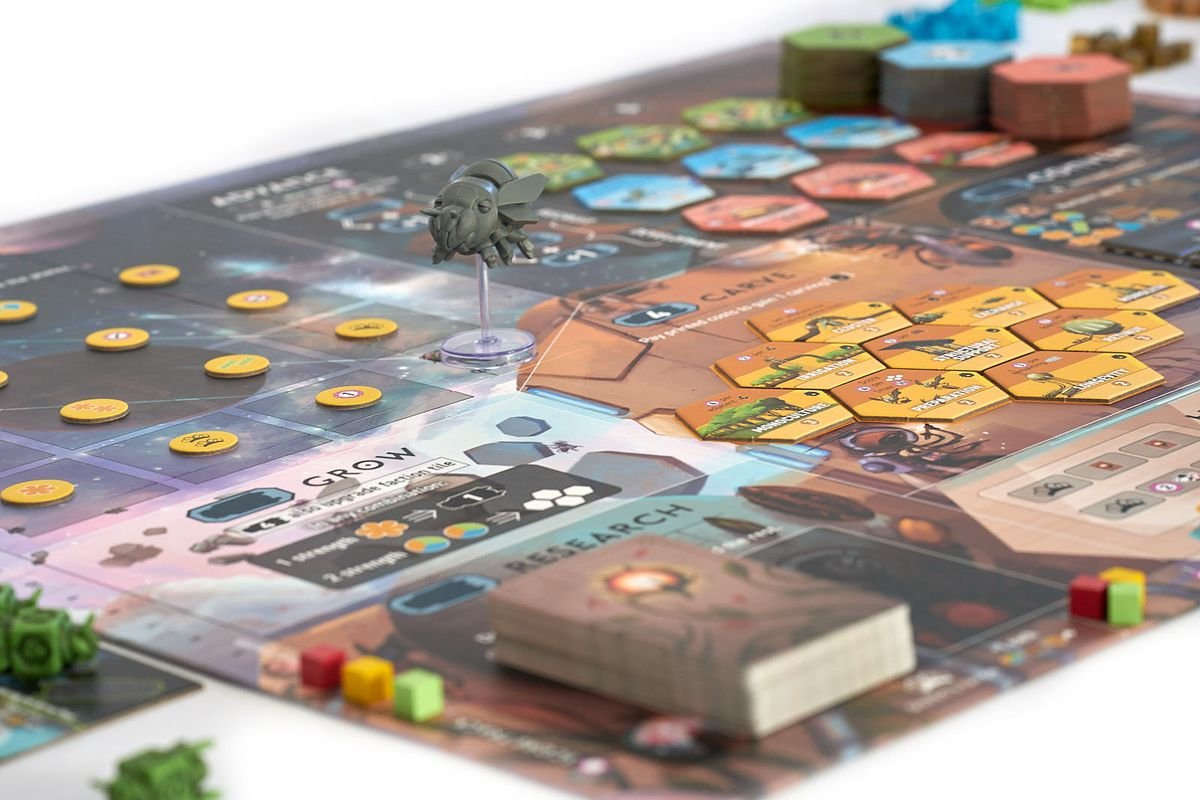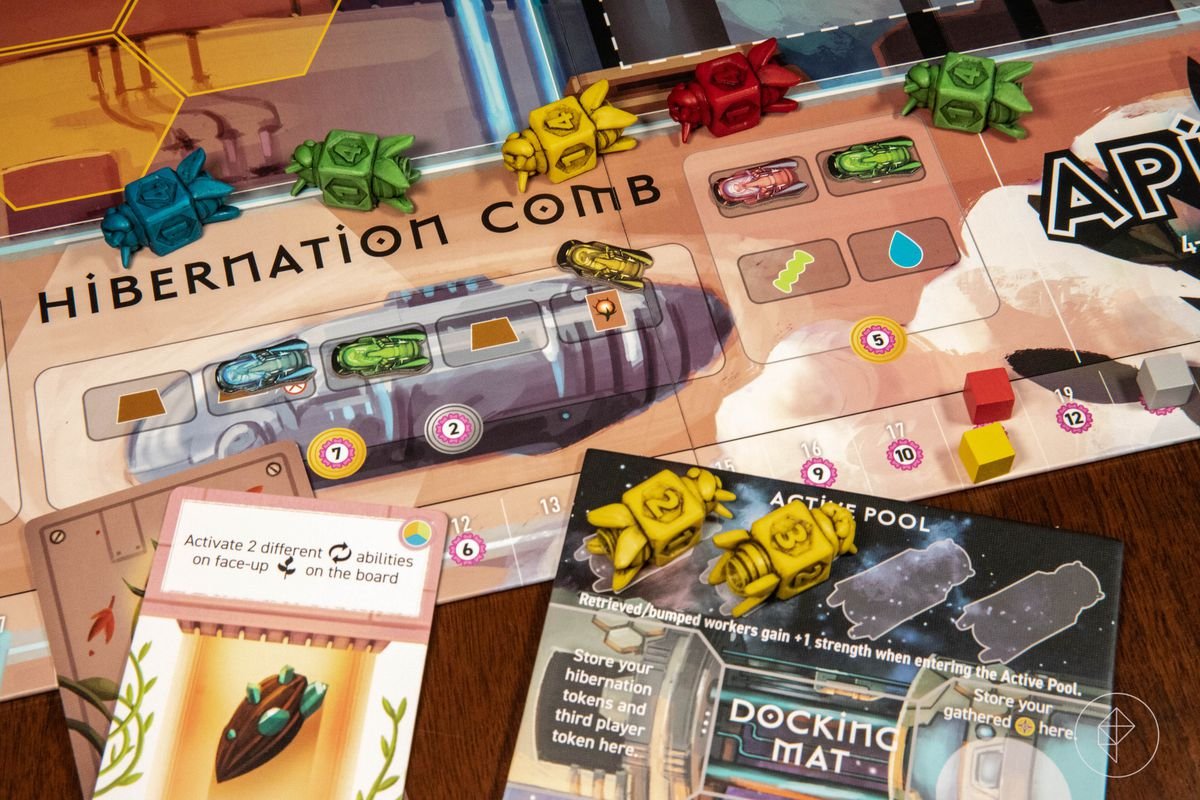Art for tabletop games is often the most expensive part of development. Case in point is the success of Stronghold Games’ recent campaign for more Terraforming Mars, which, despite earning more than $2.2 million on Kickstarter for a franchise stocked by Target, Walmart, and Amazon, elected to use content generated by artificial intelligence instead of human beings. Stonemaier Games, the publisher of Wingspan, continues to take the higher road.
Take, for example, the company’s breakout hit Scythe. The germ of the idea came not from a heady backroom playtest session, but from an article featuring the art of Polish artist Jakub Różalski. His striking pastoral scenes mixed with dieselpunk mechs created a stir when they were first shown on Kotaku. Scythe would go on to become one of the most successful board games of the past decade.
With Apiary, Stonemaier has once again gone all in on high-quality, human-generated art. The high-concept, non-confrontational game is excellent. But it hides the light of its artist, the incredible Kwanchai Moriya, under a bushel basket. Or, rather, a beehive.

Apiary is a collaborative tile-based strategy game where players compete to take the crown as the most productive member of a colony of sentient spacefaring bees. Just like Scythe, it’s asymmetrical, meaning that everyone at the table has a slightly different set of powers and goals. It takes its thematic cues from real-world melittology. It’s a science that has fascinated human beings since the dawn of civilization, and one that is increasingly important in the era of rapid and unalterable climate change. Players move from planet to planet, gather resources, and build out their colony. There’s even a little gimmick where you can teach the other bees a dance, creating your own mechanically unique way to generate victory points for the endgame.
Playing recently with a local gaming group, I actually learned something about how bees and beehives work, which is a weird thing to say about a board game. And that’s a testament to its creator, rookie game designer Connie Vogelmann (who recently contributed to our special year-end board game roundup), whose passion for the subject comes through in spades. But the way the art is implemented, both on the game board and on the game pieces, largely obscures the incredible work that Moriya has done.
How do highly advanced bees get around in zero gravity? What do their starships look like? What sort of extra-vehicular space gear do they use when they ambulate for the first time on a strange new world? How and where, precisely, do they erect a tribute to St. Louis’ Gateway Arch (an Easter egg common to many Stonemaier games) when they get there? Moriya has done the work, creating dozens of illustrations of these mighty bees going about their daily lives. But the tiny tokens where that art is located cover up most of that work with text and graphical elements. Even the sprawling art on the game board itself, which features a large, coherent scene of bees working on their colony in space, is largely obscured once you put all the game pieces on top of it.

As far as the gameplay goes, it’s a delight. The asymmetrical nature of Apiary and the huge quantity of components, some of which stay tucked inside the box each time you set it up on the table, mean that you’re unlikely to have the same experience each time you play. Meanwhile, the plastic bee-shaped pawns — which get rotated throughout the game to reflect their power relative to the other bees in the colony — are a charming mechanical adaptation. But the graphic design is a bit of a mess. And that’s a shame, at least from what I can discern. Moriya really rose to the challenge this time.
Stonemaier, much like Free League on the role-playing side of the tabletop industry, clearly spared no expense in this production. The game includes not one, not two, but three sturdy instructional booklets printed on linen paper and a double-sided guide expressly made for teaching the game to new players. The plastic pack-in is custom made with little pockets to sort all the tiles. There’s even a notch so the game board doesn’t slide around, instead keeping all the bits tightly organized when the top of the box goes back on. Cap it off with those novel bee-shaped miniatures and it’s an excellent value at $75 with loads of replayability — including a single-player mode.
Clearly, the decision to use tiles instead of cards as the vehicle for Moriya’s art plays into the scale of his illustrations as presented. If they weren’t all little hexagonal tiles, then the game board wouldn’t resemble a beehive, after all. I get it. But, as a result, the game board also sorta resembles a giant space-based spreadsheet once loaded up with tiles.
I would have loved to see a more unconventional design, perhaps one with multiple game boards. It would have also been interesting to see all the player’s bees landing on the board in a single, densely packed area — just like they do in the various pollinator hives that dot my neighborhood. You could even point an iPhone at that part of the board, yielding a fun time-lapse video of the busy bees in your game.
I am picking nits at this point, however. The game is excellent, easy to teach, and rewards multiple playthroughs. It’s one of those rare games that allows for deep concentration as well as friendly conversation in equal measure. Furthermore, it’s got me excited to learn more about Wyrmspan — the spiritual successor to Wingspan arriving later this year. The designer? None other than rookie veteran game designer Connie Vogelmann.
Apiary is currently available directly from Stonemaier Games, on Amazon, and at your friendly local game store. It was reviewed using a retail copy provided by Stonemaier Games. Vox Media has affiliate partnerships. These do not influence editorial content, though Vox Media may earn commissions for products purchased via affiliate links. You can find additional information about Polygon’s ethics policy here.















































